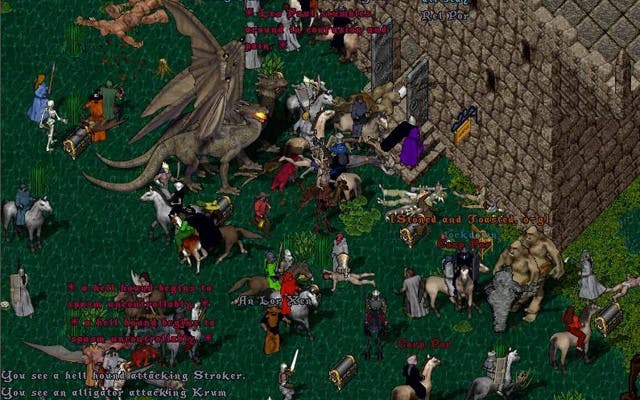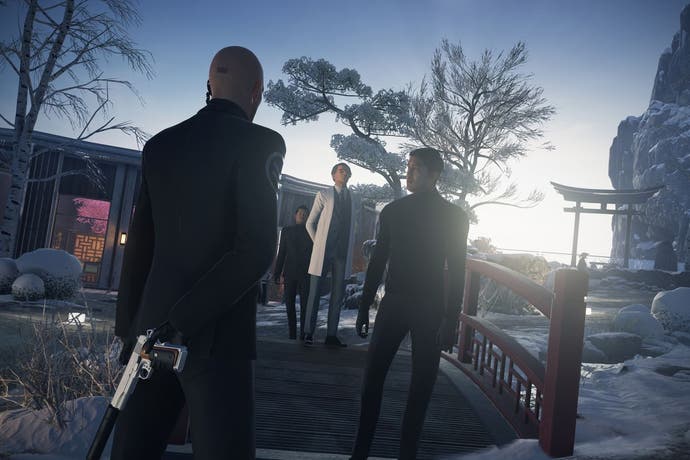How things end
Alexis Kennedy on the progress of progress.
It's 1978. You're standing in front of a cabinet of monsters. This is Space Invaders, and you'll fight the monsters until your space-craft is irredeemably compromised. Once that happens, the game will end. Once that happens, you'll begin again, with the world wiped clean. Every game always ends. Nothing remains between games but high scores, memories and finger grease.

There's no cosmic, fundamental reason that it worked that way in the beginning. Look where we are now. Now we've got games that never end, games with unlocks, games with sessions players join and drop from, games that require you to die in order to continue... and that's the mainstream stuff, before we get into the indie experiments. So how did it start that way, and how did we get here?
Two invisible hands shape and guide every design decision ever made, sometimes subtly, sometimes overtly. One hand - let's say the left - is the Hand of Commercial Context. In the case of 70s arcade machines, that meant the companies needed you to drop 10p coins at regular intervals. (Hi, American readers! 10p coins are what we have instead of sidewalks.) So they made sure that every game would end, and you'd have to pay to start a new one.
The other hand, the right, is the Hand of Technological Constraint. In 1978, memory constraints by today's standards were - I was going to say 'crippling', but I'm going to go with 'surreal'. It's always worth reminding ourselves of how much things have changed. I heard Sid Meier on a podcast earlier this week reminiscing about how shorter variable names in code were important in some environments, when he started working in the industry, because storage limitations were so critical. Also earlier this week, I saw a link to an article entitled 'How To Survive On An iPhone With Only 16GB Of Storage'. So the idea of persisting information between games was pretty radical. Space Invaders limited its high scores to four figures and its high score names to three letters, and it was being innovative.
So no wonder that early games were such constrained packets of experience. The Left Hand of commerce wanted them to stay brief, and the Right Hand of tech needed them to. So we had high scores, instadeath, permadeath. Of course just because that's how it had to be, it doesn't mean it was bad. A lot of us loved Space Invaders and its predecessors, and that tradition survives to this day - explicitly in bullet hells and in retro re-enactment competitions, implicitly in the basic idea that you play a game until you die, and then you start again.
Back to the history of endings.

Saving and loading! By the time, at age 13, I was playing games on a BBC Model B, this was a thing that some games had sometimes: Level 9 text adventures, Elite, that very peculiar Doctor Who platform puzzler that required an actual additional ROM chip to be installed in your machine. The expectation, still, back then, was that you played a game until you lost, and then restarted, but designs had begun to emerge that suggested you might want to play a game over hundreds of hours. In this respect, for home computing, the Left Hand had released its grip: you wouldn't buy more copies of a game if you had to keep restarting it. And the Right Hand had become to loosen its grip. A lot of us were still using cassette tapes for storage, but it was possible to record and reload arbitrary saves.
And this is where the world forked. All our games now contained alternate realities. All our failures and successes were reproducible. More, games served at our pleasure. If we needed to go get things done in between simulated victories, we could. Possibly we wouldn't, because we were having fun, but games became, as it were, more polite.
So there were now two models of ending: play-fail-repeat, and play-save-load-play. And with play-save-load-play, you no longer had a satisfying narrative arc guaranteed in every session. Games had been like folk-tales being retold in a different way each time, but now they could be - sometimes had to be - more like episodic TV shows. It was the rise of play-save-load-play that gave us more narrative games with more thoughtful endings.
And there were differences - baroque, delightful differences. I played a game on the Amstrad (I've just spent half an hour failing to find the name of it - help me out in the comments and I'll pretend to buy you a drink) that did something brave and ridiculous. Each year, the story goes, a hero enters the Tower and tries to ascend to its top. On the way they level up their magic and fighting skills and solve pressure plate puzzles, and they usually die, because death deletes saves. But, alarmingly, there are only thirty years before the gods destroy the world, and the world state is saved to disk. If you don't succeed in thirty years (probably a hundred-plus hours of play), you need to buy another copy of the game.
Of course you don't actually, because this was the 90s, and you'd just put a blank disk in your second 5.25" drive and copy the original game files. But what an interesting idea! It was the first time I'd seen a designer mess deliberately with the assumptions of persistence in a game. Very far from the last. But we'll get to that.

It took the Internet to birth a third model: multiplayer games which were neither play-save-load-play or play-fail-retry. In MUDs and MOOs and their spawn which we called MMOs, the world still exists whether you're playing or not. All that data is being saved anyway, so it's only natural to save your character. Retrying and failing needs to be explicitly built in; any saving and loading would allow you to subvert the world state, so it can't be allowed.
And these changed assumptions changed the design of games, again. One example: it's unnatural for characters to start over. So suddenly, we get MMO-style level grind, because you don't want characters to hit the level cap straight away. Once again, the Left Hand and the Right Hand are both at work. The Right Hand says, hey, storage is no longer a problem, so go nuts, keep your character! And the Left Hand wants you to keep levelling, so it can get your monthly subscription.
So these are are three basic models: 'play-fail-retry'; 'play-save-load-save'; and, uh, just 'play'. Over the next decade, the Right Hand of tech loosens its grip. It's really just gesturing expansively. We've got the cloud, we've got cheap bandwidth everywhere, storage is a commodity like water not like gold. The Left Hand sees those monthly subscriptions drop as MMOs fight to hold on to their players, as mobile games come in, as F2P grows like a fat vampire and everyone's trying to find new business models. So what happens?
An absolute diaspora of ending models. Games where you're expected to die. Games where you literally have to die. Games which remember your past achievements into future tries. Games which try to delete themselves when you're done. Games with permadeath, games with semi-permadeath, games with undeath. Idle RPGs which you play when you're not there, and never finish. Roguelikes and roguelites and roguelikelikes. The only way in which a game is guaranteed to end is when the player abandons their device. Everything else is game design.
I want to talk about a couple of examples which I've particularly enjoyed, and then I want to talk about THE FUTURE.

The Hitman franchise has always been a little experimental with this kind of thing. We've long been encouraged to replay levels to find alternative completions; previous titles have restricted the number of saves at higher difficulty levels. But the Elusive Target feature is something a bit different. If you don't know it, it works like this: every so often, there'll be a mission available for a week where you have to kill a unique target. Succeed or fail, the mission is gone forever. But just that one mission - you don't lose your character or your other progress or anything.
It's a lovely compromise - mission-level permadeath. And I've enjoyed it a lot more than I expected. It brings tension back into a familiar game without the risk of mouse-crushing frustration. It's a variation on an existing theme, but often that's the smartest kind of design.
And, to bring us full circle, I've been surprised by the amount of time I've put into Elite Dangerous recently. I think it's because although you're often doing quite routine things, the spectacle and the solidity of the world make it feel like an unusually complete and satisfying experience.
Part of this is the quality of the production values, and the terrifying focus of a building-full of Cambridge computer science types recreating a beloved experience. Part of it is the save model. You can play ED multiplayer or solo, but either way, you have to be online. This caused a fuss when it became apparent, because they hadn't mentioned it in their Kickstarter campaign, but whatever the reasoning, it has a powerful effect: you play a game designed for long-distance solo exploration with the permanence of an MMO.
If you fly three thousand light years and then regret it, you can't load an earlier save. You're stuck there, bucko, and the only thing to do is fly back. No do-overs and no fast travel: movement has importance, and space has distance. It's a weird design choice - again, just a variation on a theme - but it really paid off for me. And it makes sense in terms of the design principles of a game that was first released 33 years ago.
So I wonder what other kind of variations we can expect in the future. What can we expect?
The Left Hand is bringing us an unbelievably tight competition for attention, with a golden river of really good games, many of them worth hundreds of hours. And it's responding to increasing player sophistication. More players speak game natively than ever before, and as I sometimes point out here, the shared understanding of game design keeps on improving.
And the Right Hand is bringing us even easier and cheaper persistence; games on any of half a dozen objects in your home; and startlingly sophisticated AI.
So I think we might see more sophisticated world-level persistence in multiplayer games: the world recalls, and responds to, the position of rocks or the attitude of NPCs. We're already seeing some of this promised, with games like Worlds Adrift. I'm a little sceptical of how different the game experience will actually be for the player, but I think designers will go here, and I think the smart ones will hit on something smart.
I think we might see more AI involvement in games as player-like entities. We've got mobs, we've got bots, we've got AI strategy enemies. I wonder if we'll see players able to purchase agents for them to do stuff while they're offline, as their servants and heirs. I don't love that idea, but I suspect the Left Hand will give it to us.
I think we might see persistence of some, not all, things from game to game, in a more fine-grained and satisfying way. Choices which affect background state, not story state; decisions by other players which bleed into your game, in a less gimmicky way than usually happens.
But above all, I think we'll see more deliberate limitations. This is a golden age for gamers, with incomprehensible riches all around. I think we're going to ration our experiences. More roguelikes, more one-off skill challenges, more games with really permanent consequences. It's the last one that excites me most. It would never have flown when we started making games, but we're never short now of players who want a properly crazy challenge, and opportunities for them to tell the world.
This will be my last EG column: my day job is soaking up too much of my time. I've really enjoyed thinking out loud here for the last year-plus. Sorry for the politics, and thanks for the eyeballs! I'll see you about.











